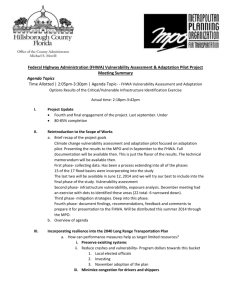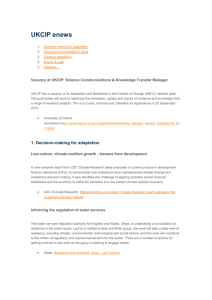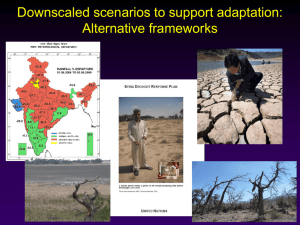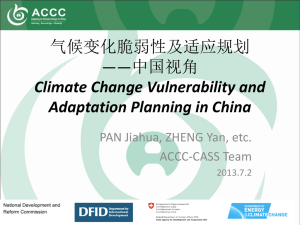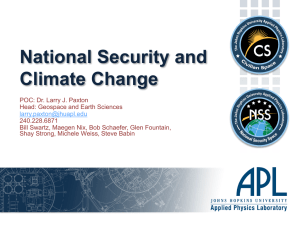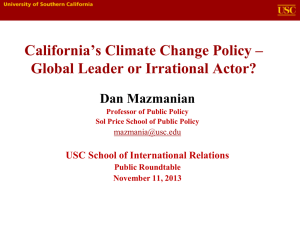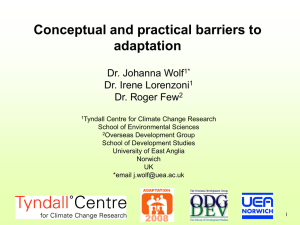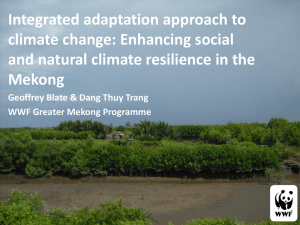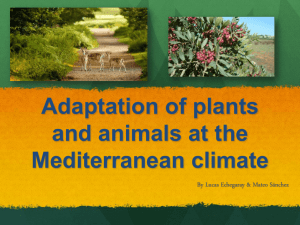Introductory presentation
advertisement
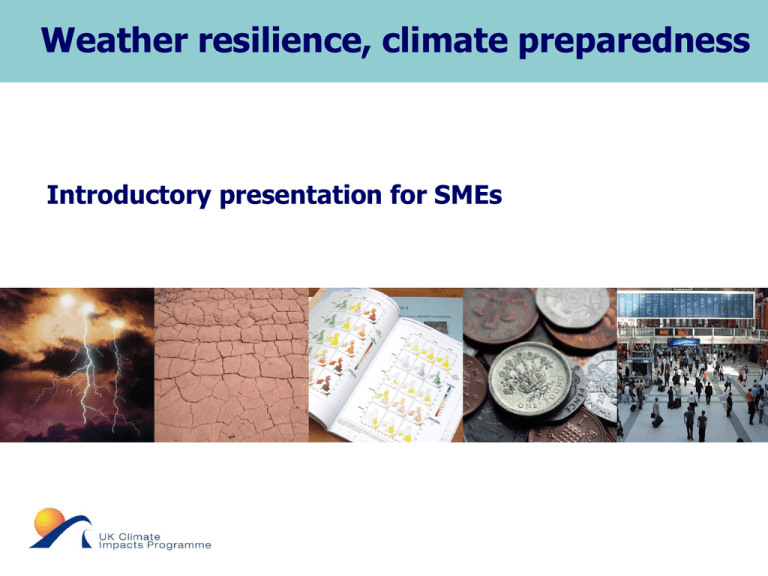
Weather resilience, climate preparedness Introductory presentation for SMEs Twin responses to climate change Mitigation: To reduce your impact ON the climate The Business emissions impacts Climate Change Adaptation: To prepare for the impacts OF the climate Adaptation and Mitigation Building the business case • There are three components to the business case for adaptation. • Understanding that the climate is changing and that there will be consequences for business is not enough. (page numbers refer to UKCIP publication ‘A Changing Climate for Business) Expected changes in the UK Changes in annual / seasonal averages • warmer, drier summers (spring and autumn too) • milder, wetter winters • rising sea levels Changes in extremes • more very hot days • more intense downpours of rain • uncertain changes in storms – possible increase in winter Web site: ukclimateprojections.defra.gov.uk Changes: summer mean max temperature 2050s – High emissions 2050s – High emissions 10% probability level: 50% probability level: very unlikely to be less than central estimate 2050s – High emissions 90% probability level: very unlikely to be greater than Change in summer mean maximum temperature (ºC) The 2003 heatwave in Europe Europe: 30,000 deaths attributed to the heat wave Forest fires and crop damage seriously impacted economy Economic losses in excess of £7.5bn England (3-14/8/03): Excess mortality All ages: 2091(17%) Hadley Centre >75: 1781(23%) Emergency hospital admissions (>75) 1490 (6%) Summer 2003 likely to be normal by 2040s, cool by 2080s European summer temperatures observations Medium-High emissions (modelled) Source: Peter Stott, Hadley Centre The need for adaptation Current vulnerability Models of future climate m o d e l l e d based on UKCP09 58% of UK businesses experienced some kind of disruption as a result of extreme weather in 2009 Unavoidable change to 2050 Depends on future emissions beyond 2050 BACLIAT - Business Areas CLimate Impacts Assessment Tool A generic framework for considering climate impacts on business areas 1. markets 2. logistics 3. process 4. finance 5. people 6. premises climate change provides both ‘challenge’ and ‘opportunity’ Markets Changing demand for goods and services • tourism: Med. is too hot so visit UK instead • food & drink: summer preferences, al fresco pavement cafes 24/7 • leisure: demand for parks, gardens, heritage • building design: passive cooling, sustainable construction • technology: monitoring, flood protection, cooling equipment, health products etc • global impacts on markets?? Logistics • disruption of supply chains arising from: – transport disruption – impacts on suppliers • just in time systems increase vulnerability • disruption to power or water supply • for smaller companies, supply chains and power supply represent a large proportion of their exposure to the climate risk Summer 2005: BMW lost hours of production equating to 50 cars as a result of delays to deliveries following riverine flooding Process Impacts on production processes and service delivery • some business processes, equipment, assets and activities are climate or temp. sensitive - food preparation and storage - some industrial processes, such as waterless printing - agriculture - server room • weather events can cause damage or disruption • climate change could reduce/ increase production efficiencies • extreme events will set new performance standards People Implications for employees and customers • poor (better?) working environment: - external: construction, agriculture - internal: offices in summer - more complaints generally • reputation as employer - attract and retain high quality staff Premises • impacts of wind, rain, storm, fire and subsidence on building fabric and structure or grounds • internal environment: less winter heating/ more summer cooling • design decisions based on historical climate data likely to be inadequate • retrofitting existing buildings represents a major challenge • sustainable construction needs to link climate change adaptation and mitigation agendas Finance • insurance issues: increased premiums; variable premiums; vulnerable locations; uncertainty • investment issues: tests for future proofing of investment, global impacts on international investment • costs: impact on raw material prices; retrofitting existing buildings and equipment could be expensive Adapt to manage risks / exploit opps Climate Change production opportunity market opportunity Environmental risk Operational risk Potential impacts on: Potential impacts on: Markets Markets Logistics Process Process Premises Finance Logistics People Finance Premises People Management response Financial risk Reputational risk Health & safety risk Strategic risk Why take a planned approach? Much adaptation will be possible without long lead times but: • the current climate may already present threats and opportunities • difficulties in recognising the climate change signal • lag times between making and implementing a decision Max temp, Summer av. 19611990 Climate vs weather • retrofitting often more costly Therefore, a planned approach that deals with climate change like any other business risk is more likely to lead to efficient adaptation How vulnerable is your business? Factors that increase vulnerability: • business requires taking decisions with long-term consequences (decades or longer) for land-use, built assets or people • specific environmental requirements for processes or equipment • health and safety issues/ requirements that could be affected by rising temperatures • heavy reliance on utility supply and transport infrastructure • maintaining business continuity is of critical strategic importance • premises in a high risk location, poorly designed, constructed or maintained Mole mapping • service developed by Medical Photographic Services • aims to help medical professionals and patients to produce a visual record of skin changes to aid diagnosis • climate change and behaviour change driving increasing market Key messages • changes in climate intersect with changes in lifestyle and other factors, presenting opportunities for entrepreneurs to identify and develop new products and services for health and social needs • these types of niche markets can often be a development from an established service rather than a totally new departure Baby Warehouse UK Ltd • an SME start up selling baby clothes and equipment • flooded in 2007 • installed some simple measures to improve resilience: online stock management system, raised storage of stock and equipment and BCM • unfortunately could not recover and went out of business Key messages • the effectiveness of their response to this flood event was highly dependent on several external organisations (insurers, contractors, local authority, neighbours) Baby Warehouse UK Ltd experience Impacts Consequences Nine months without retail premises Portacabin and container costs Knock-on effects Loss of trading Lost till system, customer records and paperwork Difficulties in meeting outstanding orders Damage to stock and equipment Repair/ replacement/ container costs E coli found in the water Health and safety risk Loss of word of mouth recommendations Significant staff time required to calculate cost of damage Massive increase in buildings insurance, which landlord may pass down Hampshire Cosmetics • an sme that manufactures, packages and supplies toiletries and personal case products to supermarkets and high street stores • ‘supplier days’ to build open conversations about issues, including resilience to climate impacts • prioritising BCP – incl. staff section on the company website to highlight weather events and so minimise disruption to factory operations Key messages • resilience to climate impacts involves building on relationships beyond the factory gates, to suppliers around the world and staff facing possible travel disruption • external expertise can provide reassurance on actions to date and a source of advice on future developments. Mole mapping • service developed by Medical Photographic Services • aims to help medical professionals and patients to produce a visual record of skin changes to aid diagnosis • climate change and behaviour change driving increasing market Key messages • • changes in climate intersect with changes in lifestyle and other factors, presenting opportunities for entrepreneurs to identify and develop new products and services for health and social needs these types of niche markets can often be a development from an established service rather than a totally new departure Key messages • we are already committed to some further climate change • The business case for adaptation can be made in terms of avoiding unexpected costs, reducing risk and making the most of opportunities • past weather events can provide insight into vulnerability to weather and climate • climate change is a business risk like any other, with adaptation implemented through existing business processes and taking advantage of existing decision points Thank you for listening www.ukcip.org.uk Kay Johnstone Project Officer (Business) UKCIP UK Climate Impacts Programme
